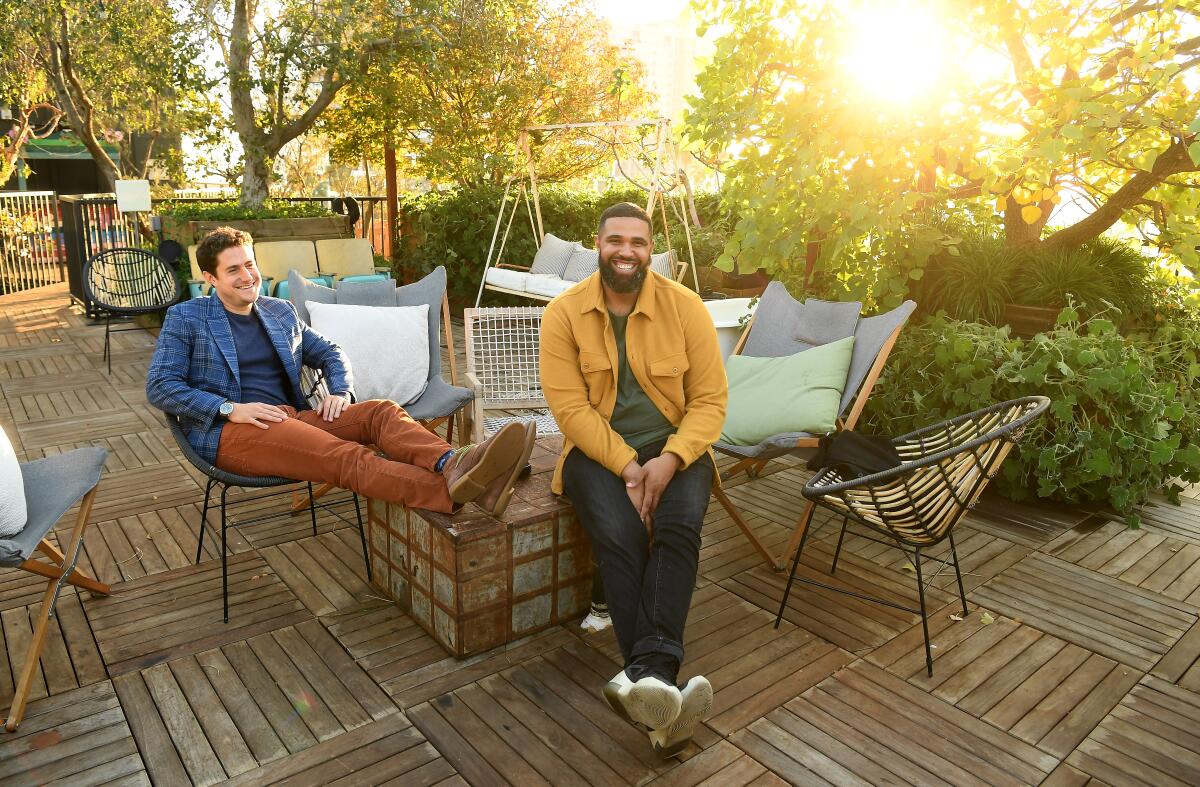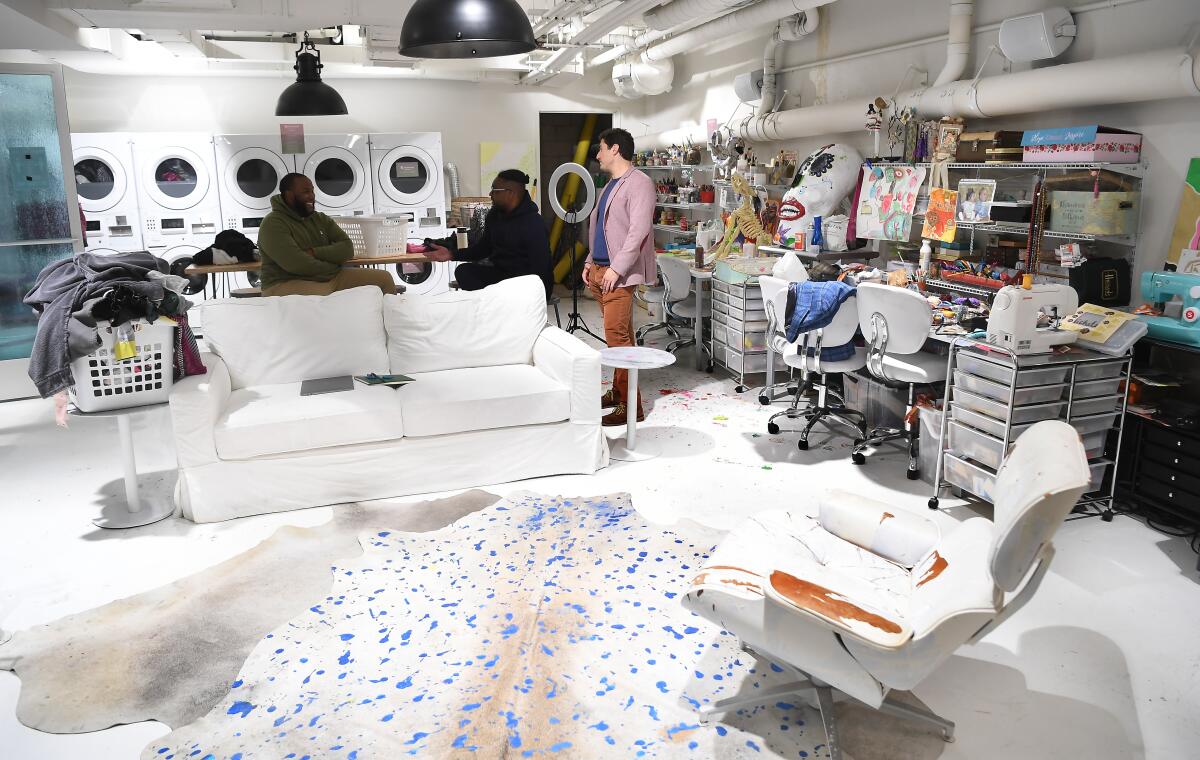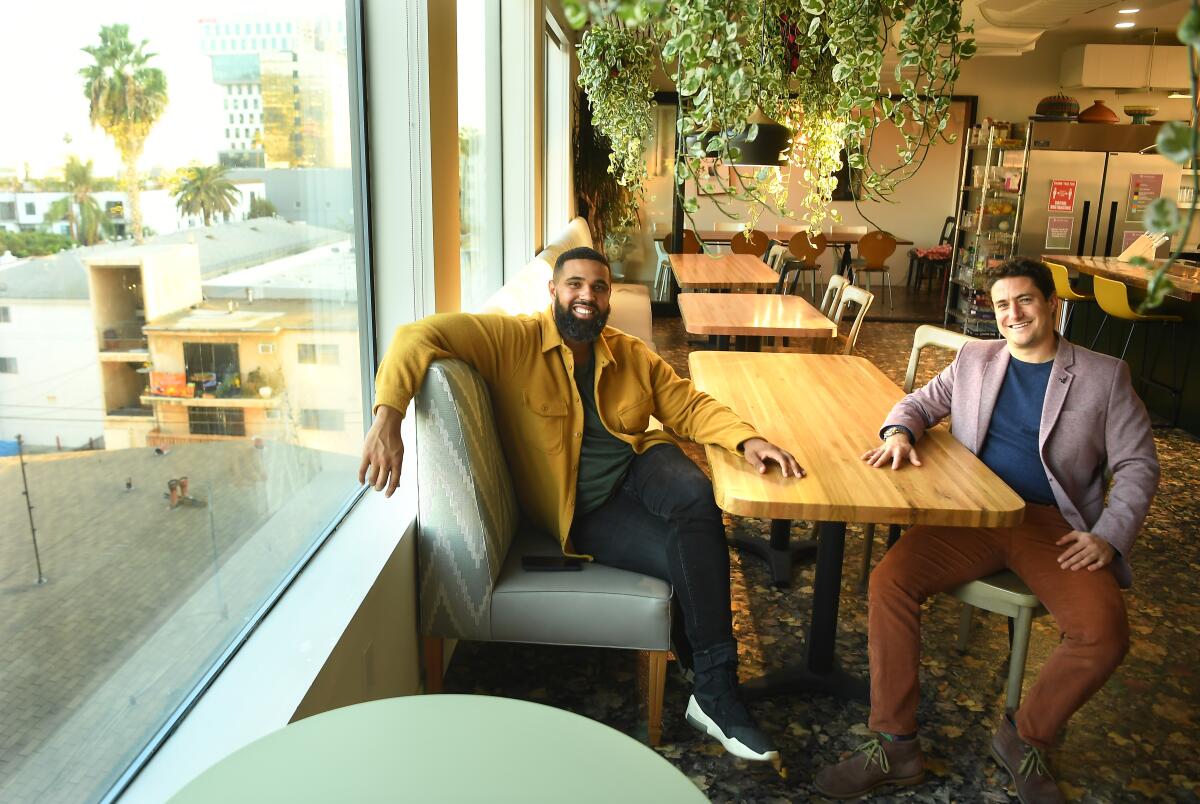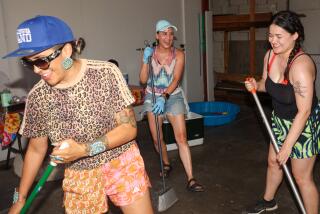This capitalist commune is trying to cure L.A.’s loneliness. Plus there’s free coffee

- Share via
On a Sunday evening in late September, with wildfire smoke hanging in the air, a few dozen people gathered in the rooftop kitchen of a Hollywood apartment building called Treehouse for their weekly communal dinner.
The building’s co-founder and chief executive, Prophet Walker, stacked plates and cleaned up cutting boards behind the tiled kitchen island, while the building’s designer, Sean Knibb, manned the pans of turmeric chicken sizzling on the stove.
The rest of the residents drank wine and chatted as they waited to eat. A woman with the vibes of an Instagram astrologer waved hi at a man who seemed to leap from a Vineyard Vines catalog. One wall of the kitchen was open to the deck outside, but people were squeezed together at small tables. Nobody was wearing a mask.
It looked like a scene from the past, or from the future. These people weren’t friends, at least not before they moved in. They weren’t family, save a few parents with their children. They were co-livers, a building-sized pod in the time of COVID, in a housing experiment with grand ambitions.
Co-living isn’t a new idea, or even a new target for tech money. Start-ups like Common, Bungalow and WeLive, the co-living division of the smoldering office-space Hindenburg WeWork, have been raising venture capital and carving up apartment buildings across the country in recent years. Most sell rooms to renters as a cheaper option, a nouveau-SRO with foosball in the laundry room and catered Taco Tuesdays on the patio.
Treehouse is taking a different tack. Walker and co-founder Joe Green, a tech entrepreneur in the Facebook orbit and big booster of psychedelic research, say they want to create the togetherness of intentional communities like co-ops, communes, or Burning Man without the anticapitalist politics or freegan cuisine. In an era when luxury is synonymous with isolation — private jets, private islands, Uber Black versus Uber Pool — they’re betting that real community can be packaged as a premium, an amenity that keeps atomization at bay as surely as heated floors banish cold feet.
From the outside, the five-story building on Carlton Way near the open cut of the 101 looks like any other upscale new construction — sans serif font, little balconies, black-painted steel. But inside its walls, things look different, starting with a floor plan heavily tilted toward shared spaces.

Rotating committees of residents determine which rental applicants get approved, and the process involves more checks of vibe than credit. Leases come with signed commitments to community values, and instead of simply showing up for scheduled events, residents are encouraged to create their own classes and shindigs for the rest of the building. Only 10% of the units are set aside as affordable for low-income tenants, but all are currently occupied by poets.
The rooms are pitched at the upper middle of the rental market in central L.A., with rents starting at $1,715 a month, plus a $210 fee to cover utilities, housekeeping, free coffee and Sunday dinners, yoga classes and other events.
Specifically, they’re pitched at people like Kimberlee Archer. When Archer left Facebook for a high-ranking job at Snap in May, the 38-year-old marketing executive could have rented an upscale pad with ocean views or found a spot up in the hills. But she wanted to live with other people, pandemic be damned. Before leaving Oakland, she googled “coliving space.”
A few weeks later, she moved into one of Treehouse’s units — really just a bedroom and a private bathroom, furnished in the style of a cozy boutique hotel (Knibb also designed the Line Hotel in Koreatown).
“I’ve lived by myself, I’ve lived with family members, I’ve lived with roommates,” Archer said. But after a career heavy on work travel, she realized she didn’t need a lot of space — she was used to living in a hotel room. “What I enjoy is having really good conversations with people I don’t work with.”
She shares a kitchen with four other suitemates and shares the common spaces of the building with the rest of Treehouse’s 40-plus residents: There’s the lobby/cafe, laundry room/art studio, screening room/Japanese-themed bar, two-story library curated by the resident librarian, and on the roof, a garden, a deck, the communal kitchen, and yes, a little treehouse, wrapped around a 100-year-old olive tree shipped in from Sacramento.
The company views the Hollywood building as a beta test for its bigger plans: a network of Treehouses across Los Angeles, from Koreatown to Compton. A complex keyed toward families interested in co-life is already in the works in Leimert Park. Residents will be welcome to stop by any other Treehouse in the city for coffee or drinks on the roof when they’re in the neighborhood.
United by loneliness
Walker and Green make an odd couple of utopian housing entrepreneurs. What brought them together was loneliness.
Walker grew up in Watts, broke someone’s jaw in a fight over a DiscMan and went to Ironwood State Prison on an assault and robbery charge when he was 16. He got out and got into Loyola Marymount University, then worked on some of L.A.’s splashiest real estate projects as a developer with Morley Builders, attempting a run for state Assembly in 2014 along the way.
Green grew up in Santa Monica and went to Harvard, where he found himself sharing a dorm with Mark Zuckerberg. He declined a chance to quit school to go work at the social network but managed to start a series of successful tech companies of his own. In 2013, he teamed up with Zuckerberg to start FWD.us, a lobbying shop that used tech money to push for immigration reform, among other issues.
By the time Green and Walker met in 2016, both had reached a similar conclusion: They had found success but felt more alone than ever.
“I never experienced lack of community until I made money,” Walker said. Growing up in Watts, he said, he felt like the child of everyone on the block. Prison, if anything, was an even more intense experience of closeness with his neighbors. “Living in a hundred-person open dorm requires radical transparency — literally there’s no dividers between 15 toilets,” Walker said. “We needed each other to not go crazy.”
After his run for office, he started thinking about how L.A. bred loneliness — the skyrocketing rents, the neighbors who never met, the way that markets and neighborhoods in the city segregate people by race, class, age and interest.
For Green, loneliness struck when he was on a spiritual sabbatical following the self-described failure of his lobbying efforts. Alone with his thoughts, he realized he had been happier as a kid — first in his Santa Monica neighborhood, with friends up and down the block, and then at Harvard’s Kirkland House, where undergrads lived in separate rooms but shared common space.
He began reading about the spread of loneliness in modern society, and was drawn to the work of Johann Hari, who argues in his book “Lost Connections” that leaving the multigenerational home and familiar neighborhood is a new phenomenon of the last 70 years, and that this isolation is to blame for increasing depression, anxiety, addiction and suicide.
In 2016, mutual friends introduced the pair at the opening of Locol, a burger stand in Watts started by celebrity chefs with the mission of bringing healthier fast food to low-income neighborhoods. Walker had helped build the restaurant with a construction crew drawn from the neighborhood, and he says he was looking for a new project that captured the same feeling of “building community and using physical space to actually do so.”
They hit it off, but Treehouse wasn’t fully born until Green went on a silent meditation retreat a few months later. “I spent several days being unable to get my mind off of a vision for this building,” Green said. When he got back to San Francisco, he spoke with his friend Michael Birch, the tech millionaire behind the elite S.F. social club the Battery, who reintroduced Green to Walker. Soon, they started scouting out locations.
Unlike most co-living companies, which reconfigure existing apartment buildings, Walker and Green saw that they needed to build from the ground up to get the mix of public versus private space they wanted.
But the decision to start from scratch presented its own challenges. Banks typically finance real estate projects based on dollars per rentable square foot, a model that assumes that shared spaces in the building, such as stairwells and lobbies, are worthless. Green and Walker had trouble finding a lender willing to back their plan. “It was, frankly, through some relationships and luck that we finally found a bank that was willing to do a construction loan,” Walker said.
A number of prominent tech names have since bought into the vision, though Green is the largest financial backer. Alexis Ohanian, who started the online community Reddit, chipped in, as did L.A. investor Arlan Hamilton and Justin Kan, who co-founded the streaming platform Twitch.
Poets and pets
By that Sunday in late September, it seemed like the vision was working, at least to a visitor, even in the face of the pandemic.
After Knibb introduced the meal — squash blossoms, jeweled rice, chapulines and a big salad along with the chicken — Elizabeth Williams, an Australian screenwriter, saw that a journalist had joined for the evening and immediately introduced herself.
Williams had moved into Treehouse after a few cripplingly lonely months in a Studio City apartment, after moving to the U.S. in 2019. She explained that she grew up in a close-knit neighborhood in Townsville, North Queensland, “no locks on doors, the kids would just swarm around like bees,” where her fondest memories were of neighborhood game nights and jam sessions. She was happy to pay extra for a built-in community.
Michele Esquivel, Treehouse’s lone inhabitant older than 50, sat eating squash blossoms and rice at a table with three building mates. Her 14-year-old daughter, Violeta, hung out at the next table over.
For years, Esquivel had wanted to move into the city from Orange County, where she worked as a nurse at Kaiser, mostly to help Violeta pursue her budding career as a slam poet. The closest place they had been able to afford was in Long Beach, until she heard about Treehouse earlier this year.
Now they live in a suite with three other poets, whose rooms make up the 10% of units that are affordable in Treehouse, which the building includes in exchange for denser zoning allowances. Esquivel said that it could feel like a “retirement home for millennials” from time to time, but she was surprised at how well it was working out.
“I felt the vetting process was long and tedious, and they asked really odd questions, but I understand it now,” Esquivel said. To maintain the vibe of the building, potential renters have to go through an extensive application process, with other renters serving on the application committee. Everyone has to sign a commitment to the building’s core values — being kind, present, curious, candid and responsible — as part of their lease.

One question had been what she would bring to the table as a resident; she had picked her cooking and her massage therapy practice. Now she sets up her table on the roof deck and gives massage sessions to residents. Other Treehousers give fitness classes in the basement gym, or teach lessons on medicinal herbs in the rooftop garden. Every Sunday, a rotating group of residents gets a $500 budget to cook or order family dinner for the whole building.
The building shares a Slack for internal announcements, which also plays host to the occasional call-out and heated conversation. To keep conflicts to a minimum, residents have set up a regular series of conversations, called Tree Talks, where the community values are often invoked to keep things kind and candid when residents are being less than responsible. A resident who washed their dog’s clothes in one of the shared machines was a source of building-wide tension. Now, after a Tree Talk, a washer and dryer set is earmarked just for items that might have pet hair on them.
Esquivel said there were some initial issues with dish-doing and living room clutter within the poets’ suite, but the benefits have outweighed the rough patches. “We would have never met anybody in these circles,” Esquivel said, and especially for her daughter she thinks it’s been “a wonderful experience, she’s learning to cohabit with other people, other age groups.”
A dissenting voice on the deck came from James Swiderski, who owns a solar energy company. He had always lived alone, and described his decision to move into Treehouse as a personal challenge. He planned to leave soon. “I’m glad I came, I don’t regret it,” Swiderski said. “But it was an overstep for me, to be honest.”
For Green, too, co-life has only been a temporary change of pace. When the pandemic first swept over California, he was staying in the spacious Beverly Hills house that his dad grew up in, which he said was “in certain ways the peak of what Americans think they want.” But Beverly Hills got lonely.
He moved into a room at Treehouse, where residents had created a building-wide bubble of viral trust after a few nervous weeks that had left the common areas mostly empty. Immediately, Green said, he could feel his COVID isolation anxiety melt away. He could post on Slack and 10 minutes later have a Settlers of Catan game going on the roof. “It felt so much better, because I had people to be around.” Still, after several weeks, he returned to his primary home in San Francisco.
Walker has no plans to leave. After the meal wound down and people began to filter back to their rooms, he finished doing the dishes, then plopped down in a booth, proud of the social feat he was in the process of pulling off: filling a building with strangers who were becoming friends, or at least fond acquaintances, against the head wind of a pandemic that has mostly driven Americans further into isolation.
Between its opening in fall 2019 and the beginning of the pandemic, Treehouse had rented only a third of its rooms. In the months since, the building has nearly filled up. “The pandemic showed us if nothing else how important community and proximity is,” Walker said. “We have all these massive online communities, and that’s like cool, cute,” but people in quarantine in New York and Italy still felt compelled to sing out their windows with their neighbors during the first lockdowns.
Walker reached for a painful memory from his teenage years in Watts to underscore the point: “I watched my best friend get murdered in front of me,” Walker said. “That should be like a death knell to anyone’s psyche,” but he credits the neighborhood with saving him.
“The entire block came outside,” Walker said, “and then when they saw what happened, every single person, just about, hugged me, like you’re gonna get through this, this sucks, but we’ve got you, and every day we’ve got you.” His hope for Treehouse is that it can build that kind of neighborhood, one where everyone knows your name and comes together in tough times, but for people like him who left their neighborhoods behind.
And of course, he hopes that it can make a lot of money at the same time. “It just so happens that through density arbitrage, through a host of laws, through real estate financials,” the Treehouse business model is “an incredible investment,” Walker said. “But truly, we’re trying to build a community.”







